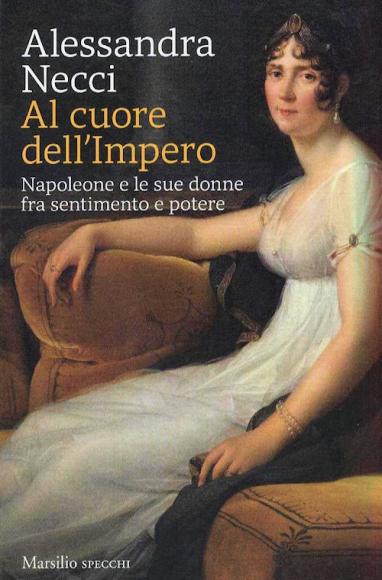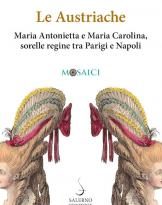Alessandra Necci
Ed.Marsilio, Venice 2020
pp. 405
Eight are the women that Alessandra Necci, lawyer and professor at the Luiss University of Rome, describes in this essay, characterized, despite the large amount of information that is reported in it, by a narrative rhythm such as to make it extremely pleasant to read. . Through these eight women, who, for better or for worse, affected Napoleon's life, the author describes the exploits, victories and defeats of the great Corso.
The mother, Letizia Ramolino, represented "The element of union and stability of the family." She gave birth to 7 children, of which three were girls. She will survive the death of her daughters Elisa and Paolina and also that of Napoleon himself who wrote about her: "The losses, the privations, he endured everything, he surpassed everything: he was a man's head on a woman's body ... I owe my fortune to the way he raised me in my youth." The mother was, "Probably, the only woman he really had an esteem for, whose positive judgment and approval he needed."
His sister Elisa, married to captain Felice Baciocchi, nominated by her brother princess of Piombino and Lucca, ambitious, unscrupulous and a lover of power, proved to have great political and diplomatic ability. She transformed Lucca into a cultural center where high-level theater and music was performed. She was the organizer, on the occasion of special occasions, of wonderful receptions, for this reason she was nicknamed, perhaps by Talleyrand, the Semiramide del Serchio.
Her sister Maria Paola, who went down in history as Paolina Borghese, was made famous not only by her beauty but also by her follies and whims. "His ruthlessness, his ease have made an era." Indro Montanelli said of her that she was the only Bonaparte who preferred love to power. "He was unfaithful to all men, but faithful to the emperor." Despite her tantrums and whims, she was the best of the sisters. She was the widow of General Leclerc, she married Prince Camillo Borghese who, subsequently, commissioned a statue of her from Antonio Canova. She was named, by her brother, reigning princess and duchess of Guastalla. “Paolina plays a leading role during her brother's exile on Elba. From a political point of view, this is the most important moment in her life. " Ella “She was able to give the best of herself in the most dramatic circumstances. She thus showing the world the measure of her own character and personality. "
Then there is the third of the sisters, “Maria Annunziata, or Carolina, who is the Bonaparte who enjoys the worst fame and worst press. Of the sisters, it is often said that Elisa is the most intelligent, Paolina the most beautiful and she the most thirsty for power. " On 20 January 1800 he married Gioacchino Murat who, in the summer of 1801, was appointed general in chief of the armies of the Cisalpine Republic and, on 15 July 1808, with the Treaty of Bayonne, king of the Two Sicilies and grand admiral of the Empire, making the his triumphal entry into Naples at the end of the summer. Napoleon, in a letter to Carolina, wrote, after Murat abandoned, during the Russian campaign, the army that the Emperor had entrusted to him: "The king of Naples, your husband, has abandoned the Army ... He is a brave man on the battlefield, but he is weaker than a woman or a monk when he does not see the enemy." To keep the kingdom at all costs, Murat and Carolina accepted the alliance with Austria, joining forces against Napoleon. Her mother, embittered, said: "My son made an irreparable mistake when he wanted to make Murat a ruler." Napoleon, however, somehow forgave him. Instead, he was embittered by Carolina's behavior. Murat, having returned to Napoleon's side, declared war on Austria, trying to raise the peninsula. Defeated, however, in the battle of Tolentino, "He will dramatically end his adventure, shot on 13 October 1815 by a Bourbon firing squad in Pizzo Calabro." Carolina, on the other hand, after having betrayed her brother "She has never reconciled with the architect of her fortunes again."
Giuseppina, whose real name was Marie-Josephe-Rose de Tascher de la Pagerie, born in Martinique, was Napoleon's first wife. The two married on March 9, 1796. She, however, was unable to give the emperor the much desired heir. He, therefore, in 1809, asked for a divorce; "In Sant'Elena, however, she will admit: I can say that she was the woman I loved most."
The Polish Maria Walewska was his mistress, a selfless lover. She remained fairly close to Napoleon in the years of the heyday, “Making him feel his affection intensely in the moment of the fall. He never wanted anything, he didn't ask for anything in return. "
Maria Theresa of Austria was the second wife of the Emperor whom he married through a marriage by proxy, which took place on 11 March 1810, in which the daughter yielded to the will of her father, Francis I of Habsburg and, therefore, to the reason of state. On March 20, 1811, their son, Napoleon François Charles Joseph, the king of Rome, was born. However, Maria Luisa, in her role “It is episodic, irrelevant, colorless, detached. She leaves no imprint, leaves no trace, she is not even capable of gestures of affection, of impulses. " When Napoleon fell into disgrace, she moved away from him, along with her son, for good.
Betsy Belcombe was a child living in Sant'Elena when Napoleon arrived on the island to spend the last years of his life as a prisoner and, probably, she was his last friend.
The 5 May 1821 "Death, so longed for, long awaited, finally loosens the wings of the Eagle."
Gianlorenzo Capano












